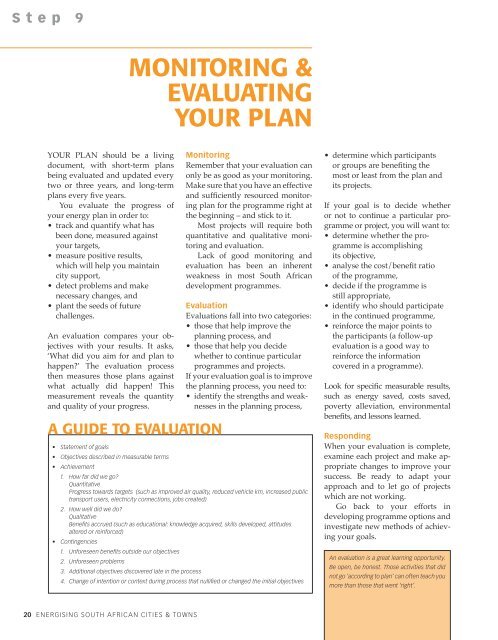Energising South African Cities & Towns - City Energy Support Unit
Energising South African Cities & Towns - City Energy Support Unit
Energising South African Cities & Towns - City Energy Support Unit
You also want an ePaper? Increase the reach of your titles
YUMPU automatically turns print PDFs into web optimized ePapers that Google loves.
S t e p 9MONITORING &EVALUATINGYOUR PLANYOUR PLAN should be a livingdocument, with short-term plansbeing evaluated and updated everytwo or three years, and long-termplans every five years.You evaluate the progress ofyour energy plan in order to:• track and quantify what hasbeen done, measured againstyour targets,• measure positive results,which will help you maintaincity support,• detect problems and makenecessary changes, and• plant the seeds of futurechallenges.An evaluation compares your objectiveswith your results. It asks,‘What did you aim for and plan tohappen?’ The evaluation processthen measures those plans againstwhat actually did happen! Thismeasurement reveals the quantityand quality of your progress.A GUIDE TO EVALUATION• Statement of goals• Objectives described in measurable terms• AchievementMonitoringRemember that your evaluation canonly be as good as your monitoring.Make sure that you have an effectiveand sufficiently resourced monitoringplan for the programme right atthe beginning – and stick to it.Most projects will require bothquantitative and qualitative monitoringand evaluation.Lack of good monitoring andevaluation has been an inherentweakness in most <strong>South</strong> <strong>African</strong>development programmes.EvaluationEvaluations fall into two categories:• those that help improve theplanning process, and• those that help you decidewhether to continue particularprogrammes and projects.If your evaluation goal is to improvethe planning process, you need to:• identify the strengths and weaknessesin the planning process,1. How far did we go?QuantitativeProgress towards targets (such as improved air quality, reduced vehicle km, increased publictransport users, electricity connections, jobs created)2. How well did we do?QualitativeBenefits accrued (such as educational: knowledge acquired, skills developed, attitudesaltered or reinforced)• Contingencies1. Unforeseen benefits outside our objectives2. Unforeseen problems3. Additional objectives discovered late in the process4. Change of intention or context during process that nullified or changed the initial objectives• determine which participantsor groups are benefiting themost or least from the plan andits projects.If your goal is to decide whetheror not to continue a particular programmeor project, you will want to:• determine whether the programmeis accomplishingits objective,• analyse the cost/benefit ratioof the programme,• decide if the programme isstill appropriate,• identify who should participatein the continued programme,• reinforce the major points tothe participants (a follow-upevaluation is a good way toreinforce the informationcovered in a programme).Look for specific measurable results,such as energy saved, costs saved,poverty alleviation, environmentalbenefits, and lessons learned.RespondingWhen your evaluation is complete,examine each project and make appropriatechanges to improve yoursuccess. Be ready to adapt yourapproach and to let go of projectswhich are not working.Go back to your efforts indeveloping programme options andinvestigate new methods of achievingyour goals.An evaluation is a great learning opportunity.Be open, be honest. Those activities that didnot go ‘according to plan’ can often teach youmore than those that went ‘right’.20 ENERGISING SOUTH AFRICAN CITIES & TOWNS












